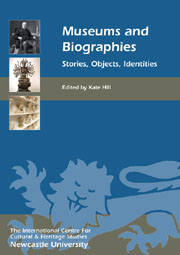Book contents
- Frontmatter
- Contents
- List of Illustrations
- Introduction: Museums and Biographies – Telling Stories about People, Things and Relationships
- INDIVIDUAL BIOGRAPHY AND MUSEUM HISTORY
- PROBLEMATISING INDIVIDUALS' BIOGRAPHIES
- INSTITUTIONAL BIOGRAPHIES
- OBJECT BIOGRAPHIES
- 12 Classifying China: Shifting Interpretations of Buddhist Bronzes in Liverpool Museum, 1867–1997
- 13 ‘Dressed like an Amazon’: The Transatlantic Trajectory of a Red Feather Coat
- 14 Individual, Collective and Institutional Biographies: The Beasley Collection of Pacific Artefacts
- 15 Sculptural Biographies in an Anthropological Collection: Mrs Milward's Indian ‘Types’
- MUSEUMS AS BIOGRAPHY
- MUSEUMS AS AUTOBIOGRAPHY
- Endpiece: The Homunculus and the Pantograph, or Narcissus at the Met
- List of Contributors
- Index
13 - ‘Dressed like an Amazon’: The Transatlantic Trajectory of a Red Feather Coat
from OBJECT BIOGRAPHIES
Published online by Cambridge University Press: 05 February 2013
- Frontmatter
- Contents
- List of Illustrations
- Introduction: Museums and Biographies – Telling Stories about People, Things and Relationships
- INDIVIDUAL BIOGRAPHY AND MUSEUM HISTORY
- PROBLEMATISING INDIVIDUALS' BIOGRAPHIES
- INSTITUTIONAL BIOGRAPHIES
- OBJECT BIOGRAPHIES
- 12 Classifying China: Shifting Interpretations of Buddhist Bronzes in Liverpool Museum, 1867–1997
- 13 ‘Dressed like an Amazon’: The Transatlantic Trajectory of a Red Feather Coat
- 14 Individual, Collective and Institutional Biographies: The Beasley Collection of Pacific Artefacts
- 15 Sculptural Biographies in an Anthropological Collection: Mrs Milward's Indian ‘Types’
- MUSEUMS AS BIOGRAPHY
- MUSEUMS AS AUTOBIOGRAPHY
- Endpiece: The Homunculus and the Pantograph, or Narcissus at the Met
- List of Contributors
- Index
Summary
INTRODUCTION
In 2000, the Brazilian Ministry of Culture prepared and organised an exhibition commemorating the 500th anniversary of the arrival of Europeans on the South American continent. Located at the Ibirapuera Park in the city of São Paulo, the exhibition was called ‘Mostra do Redescobrimento’ (‘Rediscovery Exhibit’) and aimed at showcasing a wide variety of examples of Brazilian art, including Portuguese–Brazilian, African–Brazilian, Amerindian, Baroque and popular Art. For this occasion, the Danish National Museum agreed to lend a particularly rare artefact that was produced during the first century of colonial contacts: a 1.2m-long, 60cm-wide red feather coat, most likely made by the Tupinambá indigenous group of coastal Brazil. This object had been housed at the Danish Museum for about 350 years, and was therefore making its first appearance in Brazil since its departure almost four centuries previously.
The coat made an immediate and powerful impact on the audience of its original country. The feather cape was displayed in a way that granted it an aura of aristocracy and sacredness: it stood alone, dimly lit in a glass window, at the end of a white, empty, 30m-long corridor, which visitors would reach only after having passed through a number of other rooms dedicated to Amerindian Art. The cloak was soon considered one of the most important pieces of the exhibition. In fact, it was considered one of the two ‘historical relics’ of the exhibit, alongside the notorious letter written by Pero Vaz de Caminha (1450–1500) which announced to Portuguese king Dom Manuel (1469–1521) the discovery of the lands later called Portuguese America (Caversan 2000, El).
- Type
- Chapter
- Information
- Museums and BiographiesStories, Objects, Identities, pp. 187 - 200Publisher: Boydell & BrewerPrint publication year: 2012



